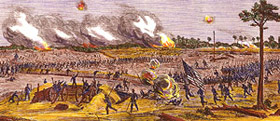Civil War Battles |
Colonial Wars |
American Wars |
Link To This Page — Contact Us —
The Battle of Fort Blakeley
April 9, 1865 in Fort Blakeley, Alabama
 |
|||||||||||||||||||||
|
Farragut’s success in the Battle of Mobile Bay in August of 1864 led to the capture of Forts Morgan and Gaines at the entrance to the bay. Mobile was considered one of the major targets of the Civil War but fear of its strong fortifications around the city and a need for troop strength elsewhere delayed advancing on Mobile.
It was not until the spring of 1865 that Gen. Ulysses S. Grant made troops available to Maj. Gen. E. R. S. Canby to commence the Mobile Campaign. Their strategy was to attack Mobile from the eastern shore of Mobile Bay, defusing the protective forts of Spanish Fort and Blakely, 4 miles north, on the east side of the Tensaw River. The next steps toward Mobile were to knock down the marshland batteries of Fort Huger and Fort Tracy, then move across the Tensaw and Mobile Rivers into the City. Maj. Gen. William T. Sherman suggested this easterly route in a letter to Canby.
On its western side Mobile was surrounded by three lines of fortifications mounting three hundred heavy artillery pieces. Water approaches to Mobile were defended by a series of underwater obstructions and island and shore batteries on the east. It was said to be the most heavily fortified city in the Confederacy.
After the disastrous defeat of the Confederate Army of Tennessee in the fall of 1864, a remnant of that army was sent to strengthen the Mobile defenses increasing its garrison to almost 10,000 troops. Commanding the Confederate District of the Gulf from Mobile was Gen. Dabney H. Maury.
Both the Union and the Confederate soldiers who fought at Spanish Fort and Fort Blakely were veterans of almost every major battle which took place in the lower Mississippi River Valley.
Canby’s movement against Mobile was a 2-pronged attack. One column was to advance from the lower part of Mobile Bay to invest Spanish Fort. The second column was to progress from Pensacola and center their efforts on Blakely.
 Click To Enlarge |
Union troops of the first column were assembled by Canby at Dauphin Island to the west and to Mobile Point on the east of the entrance to Mobile bay. These forces moved in a 32,000-man column from Fort Gaines by steamboats and over land from Fort Morgan to Fish River in lower Baldwin County; and, on March 17, moved up the eastern shore of Mobile Bay in a joint movement of land and water. A force of light draft iron-clad monitors stood off shore accompanying Canby’s column as it moved northwards towards the head of Mobile Bay. Both the land and naval columns arrived at the vicinity of Spanish Fort on March 27.
Spanish Fort had 2 major artillery fortifications that overlooked the river. On the land side, these two forts were protected by an infantry and light artillery earthwork 2 miles in length that was incomplete on its northern end. Spanish Fort was garrisoned by 3,500 veteran infantry and artillery troops.
On arrival at Spanish fort, Canby’s troops began a thirteen day siege. By April 8, the incomplete Confederate line was breached and the garrison withdrawn, with the Confederates escaping by river boats to Mobile. Loss is estimated to be 250 soldiers.
The second Column of 13,000 Union soldiers commanded by Brig. Gen. Frederick Steele moved out from Pensacola on March 20th with instructions to take Fort Blakely from the rear. It moved northward, deceptively, to appear as if heading towards Montgomery Alabama. At the railroad track at Pollard, Alabama, 50 miles north of Pensacola, it turned west towards the Tensaw River and then moved south to invest Fort Blakely. A Union cavalry brigade from the Pensacola column overran an outpost of Confederate infantry at Blakeley on the afternoon of April 1. The next day, April 2, heavy skirmishing commenced as the Union infantry and light artillery moved into position opposite the Blakely fortifications.
Fort Blakely was a formidable entrenchment built of nine connected earthen artillery redoubts mounting 41 artillery pieces. It was protected by several iron clad vessels of the Confederate Navy.
After Spanish Fort fell on April 8, the Union troops attacked simultaneously the 3 miles of Blakely breastworks at 5:30 P.M. on April 9. The strength of the 16,000 Union soldiers overpowered Blakely’s near 4,000 contingent.
From Blakely, overall some 3,400 soldiers were taken as prisoners of war to Ship Island; 250 died in battle; and, some 200 escaped via the waterways. The fall of Fort Blakeley signaled to Maury in Mobile to begin evacuation of the remaining Confederate Troops in the City.
On April 12, Mobile was declared an open city and the remaining Confederate garrison retreated with the intention of joining the remains of the Army of Tennessee, then in North Carolina. The surrender of the Army of Tennessee to Sherman on April 26 prevented that option and surrender of the Mobile garrison took place on May 5 in Citronelle, Alabama.
This small force out of Mobile was the last Confederate army to surrender east of the Mississippi River. The surrender of the Confederate forces in Texas took place later in June of 1865. Harper’s Weekly of May 27, 1865, reporting on the Battle of Fort Blakely stated, “Probably the last charge of this war, it was as gallant as any on record.”
It has long been accepted by the news media and general public that the Civil War ended on April 9, 1865, with the surrender of Gen. Robert E. Lee’s army of Northern Virginia to Grant.
Research has shown that the Battle of Blakely was the last major battle of the Civil War occurring 6 hours after Lee surrendered at Appomattox.
